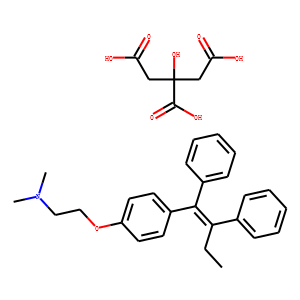| InChI | InChI=1S/C26H29NO.C6H8O7/c1-4-25(21-11-7-5-8-12-21)26(22-13-9-6-10-14-22)23-15-17-24(18-16-23)28-20-19-27(2)3;7-3(8)1-6(13,5(11)12)2-4(9)10/h5-18H,4,19-20H2,1-3H3;13H,1-2H2,(H,7,8)(H,9,10)(H,11,12)/b26-25-; |
| Reference | <div>
1. J Biomater Appl. 2016 Nov;31(5):755-772. doi: 10.1177/0885328216670561. Epub 2016 Sep 22.Tamoxifen citrate-loaded poly(d,l) lactic acid nanoparticles: Evaluation for their anticancer activity in vitro and in vivo.Ravikumara NR(1), Bharadwaj M(2), Madhusudhan B(3).</div>
<div>
</div>
<div>
</div>
<div>
The optimization of tamoxifen citrate entrapment and its release from biodegradable poly(d,l) lactic acid nanoparticles are prepared by modified spontaneous emulsification solvent diffusion method. Since the addition of tamoxifen citrate induces the formation of drug crystals from nanoparticle suspension the influence of several parameters on tamoxifen citrate encapsulation was investigated. In vitro studies for cytotoxicity, DNA ladder, and the expression of Bcl-2-Bax expression were also investigated for MCF-7 and MDA-MB-231 cells after the addition of tamoxifen citrate alone and tamoxifen citrate-poly(d,l) lactic acid-nanoparticles (encapsulated tamoxifen citrate). From results, it was noticed that the size and zeta potential of the drug loaded nanoparticles were not differed much in their physicochemical properties from drug free counterparts. The drug-loaded and drug-free nanoparticles exhibited size of in between 271.4 and 282.7 nm and zeta potential of -34 to -27.4 mV, respectively. There was significant increase in drug incorporation in the particles noticed in dichloromethane + methanol system in comparison to acetone + methanol and ethyl acetate + methanol systems. The drug was partly released from the nanoparticles after 48 h of incubation at 37℃. From Fourier transform infrared spectroscopy and differential scanning calorimetry data demonstrated drug-polymer characteristics within the nanoparticles and unincorporated drug that appeared in the form of crystals from polarized microscopic study. MCF-7 and MDA-MB-231 cells were more sensitive to tamoxifen citrate-poly(d,l) lactic acid-nanoparticles than tamoxifen citrate alone. DNA ladder and the expression of Bax to Bcl-2 ratio were much higher in tamoxifen citrate encapsulated in nanoparticles than that in tamoxifen citrate alone. These results demonstrated the feasibility of encapsulation of tamoxifen citrate and its enhanced </div>
<div>
efficiency in vitro and in vivo studies.</div>
<div>
</div>
<div>
2. J Surg Res. 2015 Jan;193(1):429-34. doi: 10.1016/j.jss.2014.08.013. Epub 2014 Aug 14.</div>
<div>
</div>
<div>
Tamoxifen citrate: a glimmer of hope for silicosis.Yoldas O(1), Karaca T(2), Bilgin BC(3), Yilmaz OH(4), Simsek GG(5), Alici IO(6), Uzdogan A(7), Karaca N(8), Akin T(9), Yoldas S(10), Akbiyik F(11).</div>
<div>
</div>
<div>
BACKGROUND: Inhalation of crystalline silica nanoparticles causes pulmonary damage resulting in progressive lung fibrosis. Currently, there is no effective treatment for silicosis. Tamoxifen citrate is a selective estrogen receptor modulator, which is one of the adjuvant treatment choices for breast cancer. It is also known with its inhibitory effect on the production of transforming growth factor-beta (TGF-β) and studied for the anti-fibrotic effect in some fibrotic diseases. The aim of the study was to determine the effect of tamoxifen citrate on the prevention of pulmonary fibrosis and the treatment of silicosis.</div>
<div>
METHODS: A total of 100 adult female Wistar Albino rats (200-250 g) were used in this study. The rats were divided into five groups including 20 rats in each. Rats were exposed to silica for 84 d in all groups. In group 1, rats were sacrificed on the day 84 without receiving treatment. In group 2, rats received 1 mg/kg tamoxifen (tmx1 + 1), from the first day of the study for the whole 114 d of the study. In group 3, (tmx10 + 10) rats were given 10 mg/kg tamoxifen from the first day of the study for the whole 114 d of the study. In group 4 (tmx1), rats were started 1 mg/kg of tamoxifen on day 84 and were given until day 114. In group 5 (tmx10), rats were fed with 10 mg/kg tamoxifen starting from day 84 to day 114. All rats except group 1 were sacrificed on 114 day of the study. Lung inflammation and fibrosis scores, serum TGF β levels, lung smooth muscle antigen and tissue transforming growth factor β (t-TGF-β) antibody staining levels, and number of silicotic rats were compared between groups.</div>
<div>
RESULTS: Silicosis was caused successfully in all rats in group 1. There were six silicotic rats in group 3 and it was the lowest number of all groups. Plasma TGF-ß levels and fibrosis score were significantly lower in all groups when compared with the control group. Tamoxifen could have preventive or treating effects in silicosis and found that lung fibrosis score was significantly lower in rats treated with tamoxifen.</div>
<div>
CONCLUSIONS: Tamoxifen treatment after and/or before induction of silicosis decreased lung fibrosis score with blood TGF-β levels. We hope that this study may introduce a new indication as prophylactic use of tamoxifen in high-risk groups for silicosis and for treatment of silicosis.</div>
<div>
</div>
|

